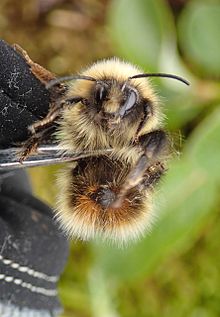Bombus balteatus
| Bombus balteatus | |
|---|---|

| |
| Scientific classification | |
| Domain: | Eukaryota |
| Kingdom: | Animalia |
| Phylum: | Arthropoda |
| Class: | Insecta |
| Order: | Hymenoptera |
| Family: | Apidae |
| Genus: | Bombus |
| Subgenus: | Alpinobombus
|
| Species: | B. balteatus
|
| Binomial name | |
| Bombus balteatus | |
Bombus balteatus, the golden-belted bumble bee, is a species of bumblebee with a boreal and high altitude distribution in northern Eurasia and North America.
Range and distribution
This species is found in
Morphology
Bombus balteatus is a long-tongued bumblebee. Often the tongue length reaches two-thirds or more the length of the body.[5] This morphological feature allows them to specialize on flowers with long corollas.[6] In North America, workers can be identified by a distinctive black abdomen pattern and robust body.[5]
Systematics
The most closely related species are Bombus hyperboreus, Bombus frigidus, and Bombus mixtus, which all occur in Western North America and Arctic Europe.[5]
Effects of climate change
In the Rocky Mountains, USA, many native plants species include flowers with elongated corollas. With abundant resources, B. balteatus can be a dominant species in the ecosystem.[7] However, Rocky Mountain bumblebees, including B. balteatus and Bombus sylvicola, have shown changes in abundance and foraging range as long-tubed floral resources are declining at higher altitudes; they have also exhibited a trend towards shorter tongues over the last 40 years.[6] This is indicative of niche expansion; although this species of bumblebee is considered highly specialized, it is now adapting to forage on a broader range of morphologically diverse flowering plants.[6] Immigration by short-tongued bumble bees into higher altitudes, as well as an increase in the number of Bombus balteatus individuals with shorter tongues, has also occurred as a result of warming and climate change. This creates new competition for long-tongued B. balteatus for limited floral resources.[6]
References
- ^ a b Hatfield, Richard. "IUCN Assessments for North American Bombus spp. for the North American IUCN Bumble Bee Specialist Group". ResearchGate. Retrieved 2017-04-25.
- ^ ITIS Report
- ^ "Map of Bombus balteatus". Discover Life. Retrieved 4 November 2012.
- ^ "North American bumblebees". Bumblebee.org. Retrieved 4 November 2012.
- ^ ISBN 978-0691152226.
- ^ PMID 26404836.
- PMID 26214921.

